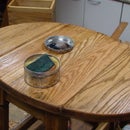Introduction: Simple Handbuilt Shooting Board
A shooting board is a great workbench appliance I can't live without. It allows you to square up a board using a handplane. A tool that is well adjusted is able to yield you near pinpoint-accuracy, which can really improve your woodworking projects. That sounds nice right? Let's begin.
First you need to understand how it works. The square wooden block is the fence. You put a piece of wood against it, with the not square side facing the lower layer of meranti. With a well-tuned and laterally adjusted handplane, plane away at the end grain by using the meranti plywood as a 'runway'. Push the sole of the plane against the layer of birch to keep it square. Now that you understand the concept, let's start building.
Step 1: Start With the Elements
Every woodworking project starts with collecting all the elements: the building substrate from which your project will rise! I used a reclaimed beam of antique oak for the fence, and a few squares of birch and meranti plywood for the base. Whenever I'm referring to antique oak, I mean oak that has been subject to aging for a long time. The older the wood, the darker the colour. You can see this on old cigar boxes as well. I like working with antique oak because of, well, everything! Its colour, the aroma, and just how easily it works. It does dull your planes fairly quickly though, so keep your sharpening appliances nearby!
Step 2: Making the Fence
First of all, I needed to carve a square piece from the oak beam, which wasn't square at all. After quickly honing my tools, I went at it. With a sharp handsaw, I broke the beam down into smaller bits, which resembled the final dimensions more closely. After that, it was time for planing. I used a stanley no.3 smoother to establish the reference surface. After that, I could plane all four sides square referencing from there. With a bench hook and a tenon saw, I cross cut the piece to its final length, and used my old shooting board to trim the edges up a little bit. I drilled two holes and countersunk them. The holes are a bit bigger than the screws, this allows for a bit of adjustability. As a final detail, I added my brand or Maker's mark.
Step 3: Building the Base
With the fence finished up, I was ready to build the base. I cut two rough squares of plywood, one from birch and one from meranti. The trickiest part now is getting the pieces square and have them match each other at the same time. Here's how I did it.
1. I cut the birch top piece as accurate as possible. I then squared it up perfectly on my old shooting board.
2. Now I cut the piece of meranti. Because I cut it from a large sheet, it already had one straight side. I marked this side and used it as a reference edge while shooting. If your piece doesn't have an edge like that, use a handplane to make it straight.
3. Using the piece of birch plywood, a square and a marking knife, I marked the two short ends on the meranti plywood. Now three out of four sides are done. The last one is most likely out of square. It is not vital to get this one right, but getting it perpendicular to the birch layer just makes it that bit more sexy.
4. To get the last side perpendicular, scribe a line right along the edge of the sheet of birch using a marking knife. With a set of dividers or a compass, find the spot that lies the farthest away from that line. Do this on two spots. With a marking knife and a straightedge, connect these two spots with a marking knife. Saw away the waste and plane flush to the line.
Step 4: Putting Everything Together
Now comes the most important part: the assembly! The only comforting thing I can give you is this: the only important detail is that the fence should be square to the 'inner' edge of the sheet of birch plywood. With this said, you can scribe a knife line square to said side. Carefully align the fence and screw everything tight. Now comes the best part. Remember we left the holes a little wider than the screws? This allows for extra adjustment, so you don't need to get it right the first time. Tap the fence in place untill everything is perfectly square. Now turn the fence around, and knock in a few nails. You can really let some steam off now. Let go of all those frustrations, your boss, your ex-girlfriend, your mother-in-law, the fact that you just turned your thumb into apple sauce...
And there you have it! A simple tool like this doesn't need to be finished to be functional. I know you will enjoy it as much as I do!
Before you go...
Step 5: Watch the Video Tutorial!
And thanks for reading! Please subscribe so you won't miss anything.

Participated in the
Plywood Contest













